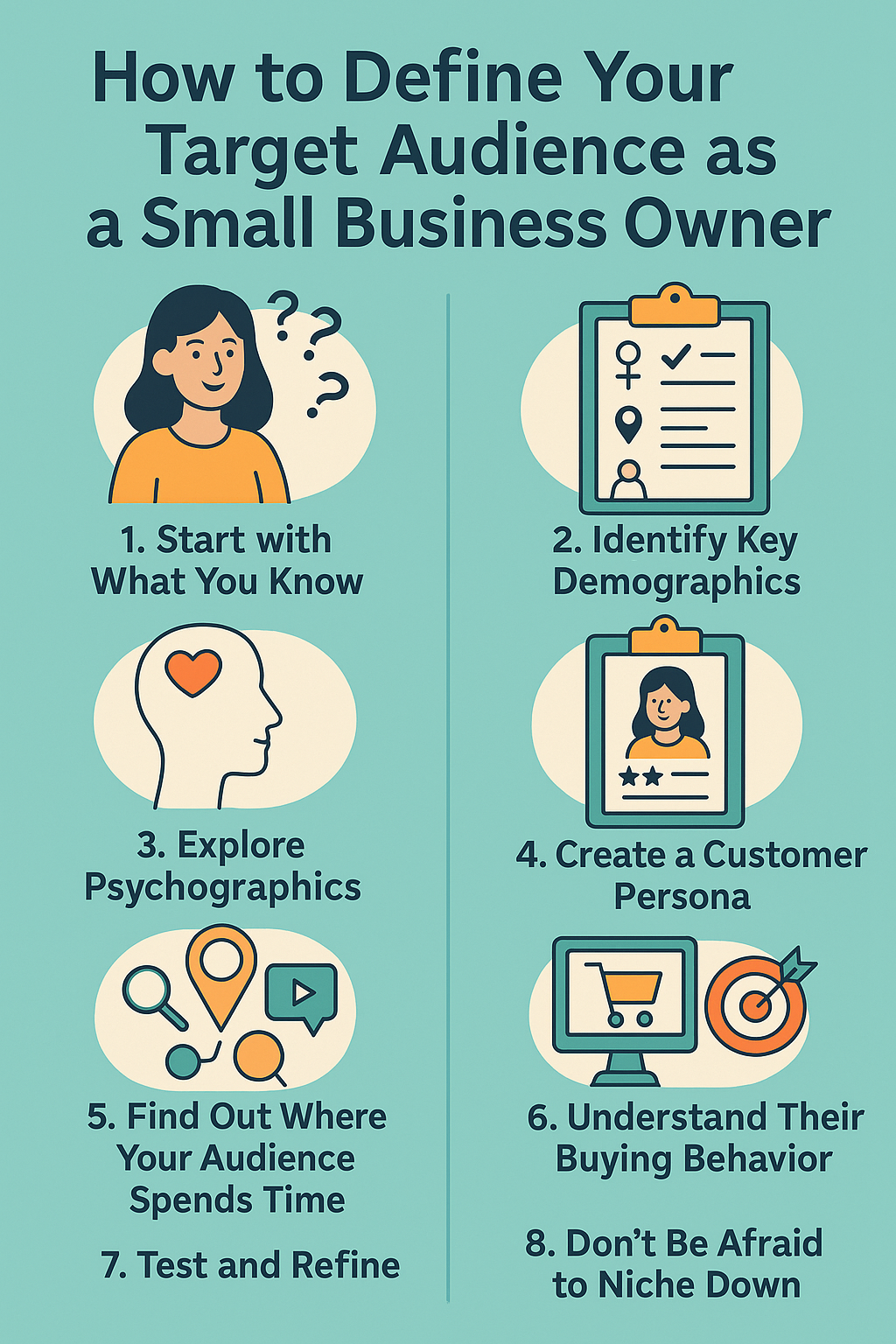One of the biggest mistakes new entrepreneurs make is trying to sell to everyone. The truth is, the more specific you are about who your business serves, the easier it is to attract loyal customers and stand out from the competition.
Defining your target audience helps you create better products, design smarter marketing, and spend less money reaching the right people. In this guide, we’ll walk you through the steps to clearly define your ideal customer and use that information to grow your business with confidence.
What Is a Target Audience?
Your target audience is the specific group of people most likely to buy your product or service. They share similar characteristics, problems, or goals — and your business offers a solution tailored to them.
Instead of asking, “How can I reach more people?”
Ask, “How can I reach the right people?”
A well-defined target audience makes every decision easier — from branding to pricing.
Why It’s So Important to Define Your Audience
Knowing your audience helps you:
- Write better marketing messages
- Choose the right social media platforms
- Create offers that solve real problems
- Build deeper connections with customers
- Avoid wasting money on broad or irrelevant ads
The better you understand your audience, the better you can serve them.
Step 1: Start with What You Know
Even if you haven’t made a sale yet, you probably have an idea of who your product or service is for.
Ask yourself:
- Who would benefit most from what I offer?
- Who has the problem I’m solving?
- What kind of people do I enjoy helping?
If you already have some customers, look at their demographics, feedback, and buying habits.
Step 2: Identify Key Demographics
Demographics help you define your audience based on measurable characteristics.
Consider:
- Age range
- Gender
- Location
- Occupation
- Income level
- Education level
- Marital/family status
This helps you narrow down your focus and craft a message that feels personal and relevant.
Step 3: Explore Psychographics
Psychographics go deeper than demographics. They describe how people think, what they believe, and how they behave.
Ask questions like:
- What are their goals and dreams?
- What challenges or frustrations do they face?
- What values are important to them?
- How do they make buying decisions?
- What kind of content do they consume?
Psychographics are what help your brand connect emotionally with your audience.
Step 4: Create a Customer Persona
Now that you have the data, combine it into a customer persona — a detailed, fictional profile that represents your ideal client.
Example:
Name: Sarah
Age: 34
Occupation: Freelance graphic designer
Location: Urban area in the U.S.
Goals: Build a stable income and grow her personal brand
Challenges: Time management, inconsistent clients
Values: Flexibility, creativity, independence
Refer to this persona when creating content, writing emails, designing ads, or developing products.
Step 5: Find Out Where Your Audience Spends Time
To reach your ideal customers, you need to know where they hang out — both online and offline.
Ask:
- What social media platforms do they use? (Instagram, LinkedIn, TikTok, etc.)
- Do they read blogs, watch YouTube, or listen to podcasts?
- Are they in Facebook groups or online communities?
- Do they attend specific events, webinars, or trade shows?
Meet them where they already are — don’t expect them to come find you.
Step 6: Understand Their Buying Behavior
To sell more effectively, understand how your target audience makes decisions.
Consider:
- Are they impulse buyers or careful researchers?
- Do they care more about price or value?
- Do they need social proof (reviews/testimonials)?
- Are they more likely to respond to emotion or logic?
This knowledge helps you craft marketing messages that actually convert.
Step 7: Test and Refine
Your first version of a target audience is a starting point, not the final answer. As your business grows, you’ll gather real-world feedback that will help you refine your audience.
Ways to gather insights:
- Track engagement on different content types
- Use polls or surveys
- Analyze email open rates and ad performance
- Talk to your actual customers
The more you learn, the more focused (and profitable) your business will become.
Step 8: Don’t Be Afraid to Niche Down
Many entrepreneurs worry that narrowing their focus means losing customers. But in most cases, the opposite is true.
When your message is specific, the right people feel like you’re talking directly to them — and they’re more likely to buy.
You can always expand later. But when you’re starting out, niching down helps you build momentum and clarity.
Final Thoughts: Know Who You Serve
Defining your target audience isn’t about excluding people — it’s about serving your ideal customer better. When you know exactly who you’re helping and what they need, everything becomes easier: marketing, product development, branding, and even customer support.
So take the time to get clear. Listen to your market. Talk to your customers. The more you know about them, the stronger your business will be.
